¶ 1. Introduction
Follow the instructions in this guide to install T6 Enterprise™, a platform for Tech6 products: T6 Planning, T6 Consolidation, T6 IFRS, T6 HR, and T6 Performance.
This installation guide is intended for system administrators and technical consultants.
¶ 2. Installation Prerequisites
¶ 2.1 OVERVIEW
The installation of T6 Enterprise requires that certain software be properly installed and configured, as described in this chapter.
¶ 2.2 SOFTWARE
Certain software is necessary for the correct installation of T6 Enterprise, as outlined below.
Microsoft Windows Server, one of the following options:
- Microsoft Windows Server 2012 R2 (Standard or higher).
- Microsoft Windows Server 2016 (Standard or higher).
- Microsoft Windows Server 2019 (Standard or higher).
Microsoft SQL Server, one of the following options:
-
Microsoft SQL Server 2012 SP4 (Standard or Enterprise with Service Pack 4 or higher).
-
Microsoft SQL Server 2014 (Standard or higher).
-
Microsoft SQL Server 2016 (Standard or higher).
-
Microsoft SQL Server 2017 (Standard or higher).
-
Microsoft SQL Server 2019 (Standard or higher).
-
Microsoft SQL Server 2022 (Standard or higher).
-
Internet Information Services (IIS) version 8 or higher.
Ensure that "IIS 6 Management Compatibility" is installed. For more details and tips on IIS, refer to the "T6 Enterprise - IIS Setup Tips" manual. -
.NET Core 8.0 Runtime & Hosting Bundle for Windows (v8.0.0)
Download .NET Core 8.0 -
Microsoft .NET Framework 4.8 or higher:
Download .NET Framework 4.8 -
Report Viewer 2012:
Download Report Viewer 2012
¶ 2.3 CONFIGURATIONS
The installation of T6 Enterprise also requires the prior configuration of certain components, described below.
¶ 2.3.1 Windows Server
- Windows User Account: T6 Enterprise can be run using a new Windows user account. Create and configure this account, ensuring that the new user is a member of the Administrators and IIS_WPG groups.
- Server Name: During the installation of T6 Enterprise, use the server name instead of localhost.
- WebSocket Protocol: The WebSocket feature must be installed on the Windows server hosting the T6 Enterprise application.
- To install, access the Control Panel, then click on "Turn Windows features on or off."

The following screen will display the initial step of the Add Roles and Features Wizard. Click Next to proceed.
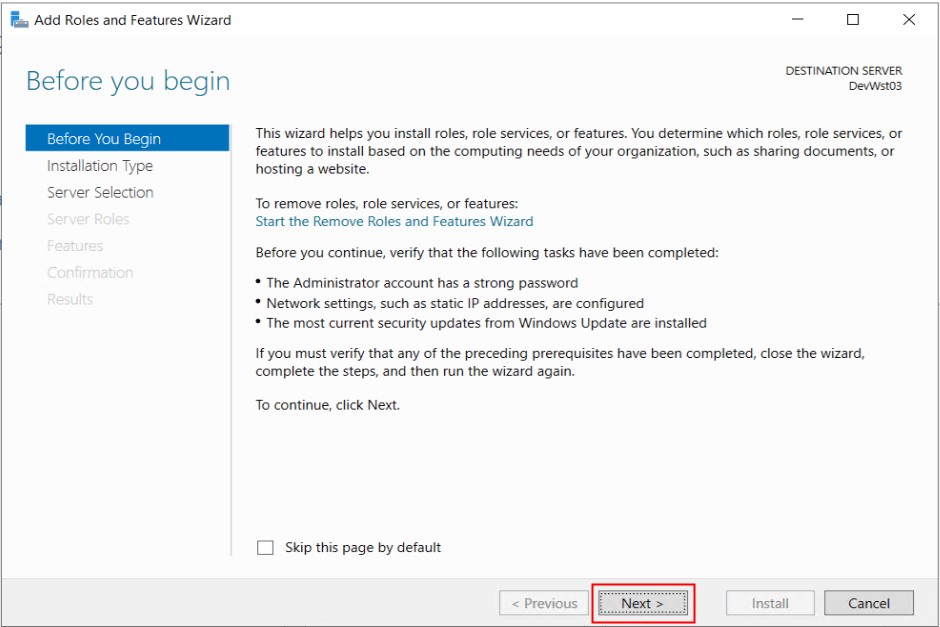
On the next screen, you should select "Role-based or feature-based installation." Click Next to proceed.
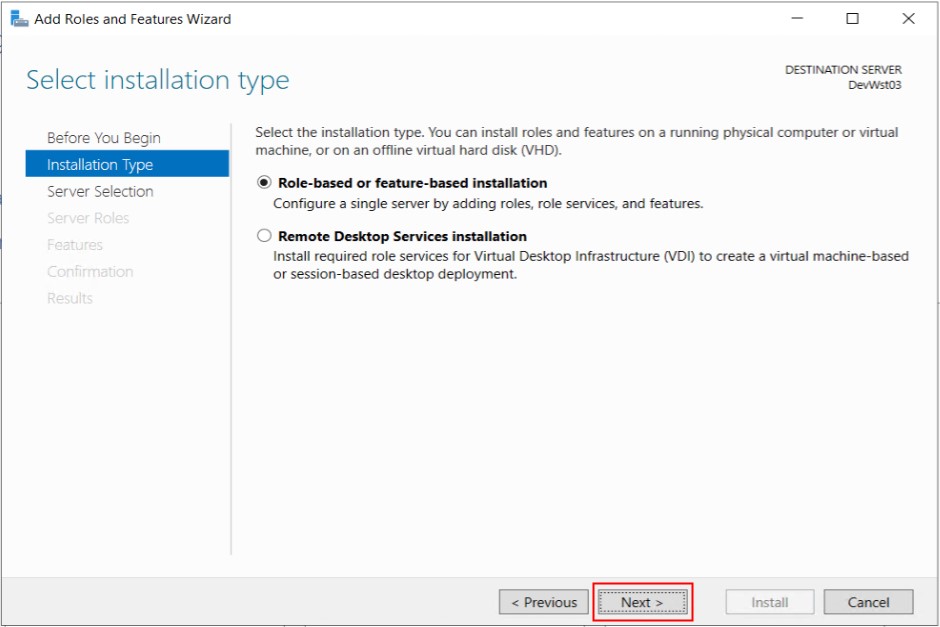
In this next screen, you will select the target server. Click Next to proceed.
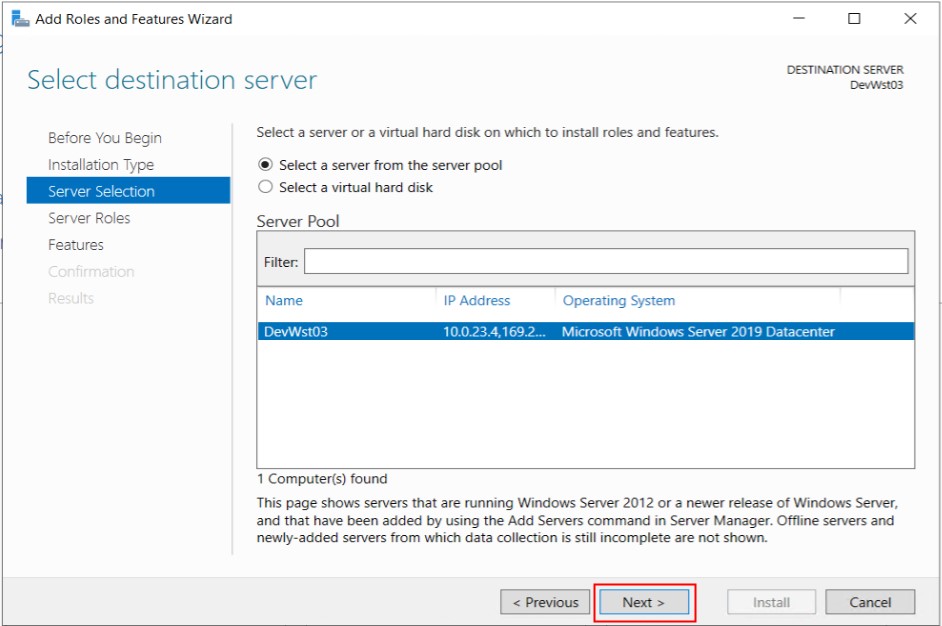
On this screen, check whether the WebSocket Protocol option is already installed. If it's installed, you can cancel the wizard. Otherwise, click Next to proceed and follow the Windows instructions to complete the installation.
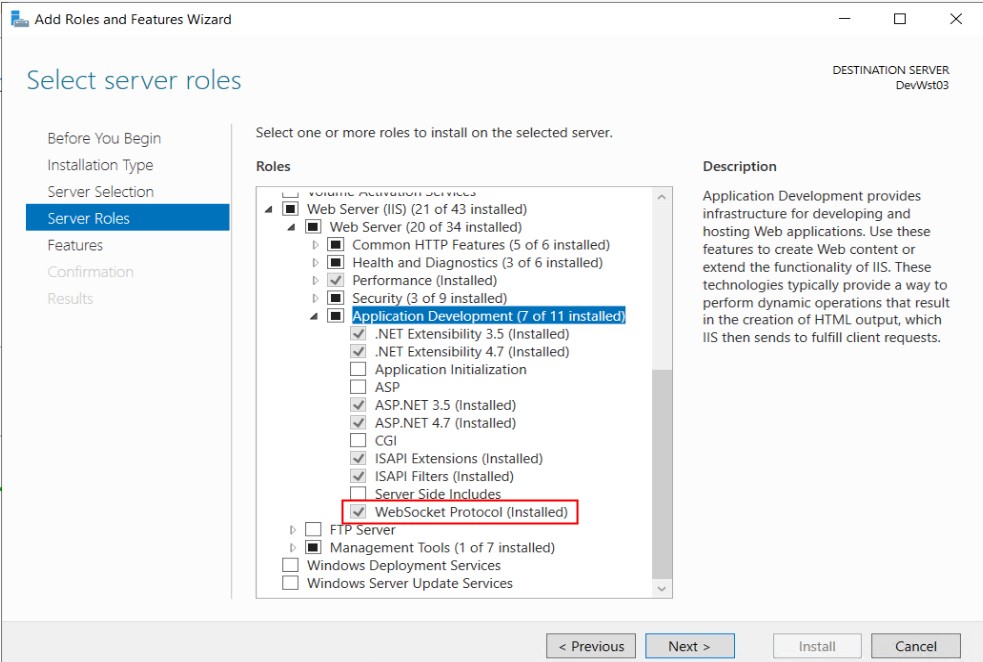
¶ 2.3.2 SQL Server
-
SQL Server Installation Options: The correct functioning of T6 Enterprise depends on certain SQL Server options, listed below.
- Database Engine Services
- Integration Services (only if used for ETL)
- Workstation Components and Development Tools
-
Required Configurations: The services listed above must run under the Local System or Network Service account.
- The SQL service must be started.
- The TCP protocol must be enabled in SQL Server Network Configuration and SQL Native Client Configuration.
-
New Database: A new database must be created and configured before starting the T6 Enterprise installation. The installer will automatically create the necessary tables and data during the installation process. Follow the steps below to create a new database.
- Open SQL Server Management Studio.
- Connect to the Database Engine where you want to create the T6 Enterprise database.
- After connecting, right-click on the Database folder in Object Explorer and select the New Database option.
Note
The database COLLATION must be set to Latin1_General_CI_AI.
- Creation of T6 Enterprise User: It is recommended to create a new user who will connect to and manipulate the application database. Ensure that this new T6 user has the attributes described below and that the language is set to English.
- SQL Server Authentication or Windows Authentication, depending on how you want to connect.
- If you choose SQL Server Authentication, configure and confirm a password. Passwords must meet security policies, i.e., complex passwords.
- On the General page, under Default Database, select the new T6 Enterprise database created for this purpose.
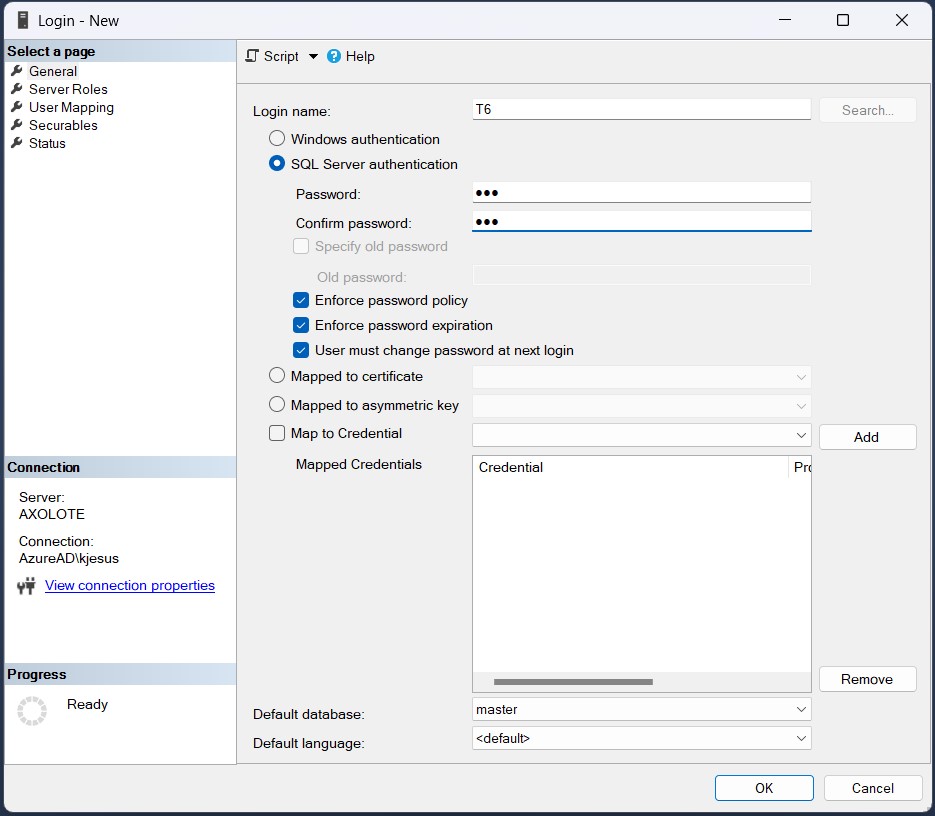
- On the User Mapping page, under Users Mapped to This Login, check the Map checkbox for the new T6 Enterprise database created in the previous step. Under Database Role Membership, select the db_owner option. The public option should already be selected by default.
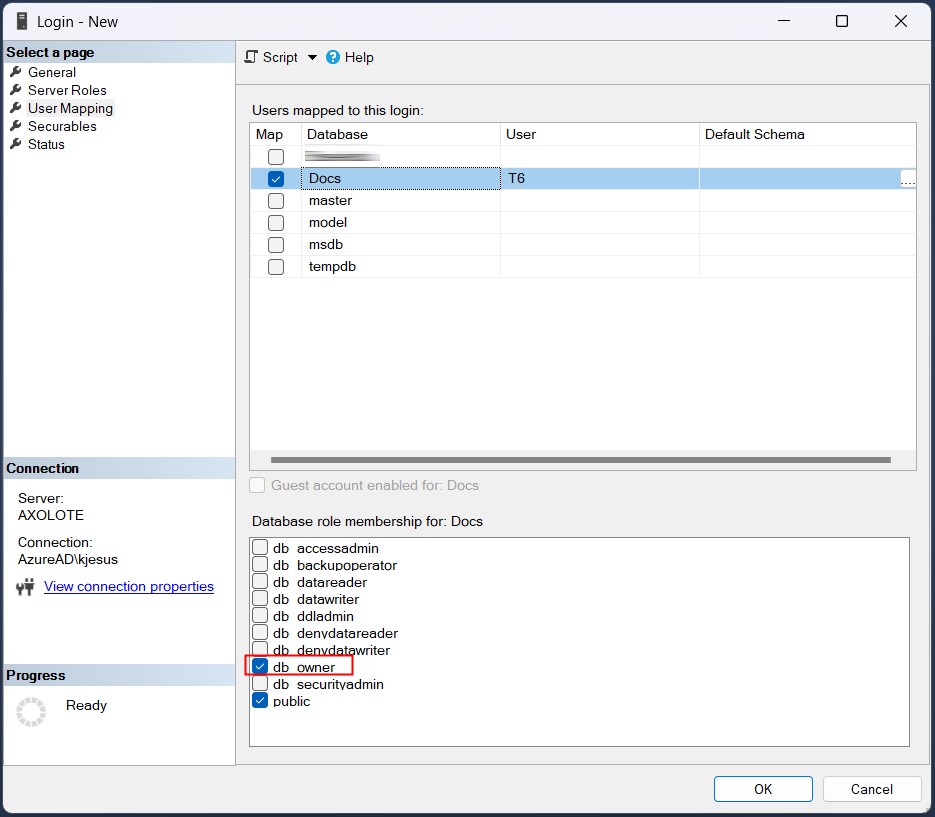
- On the Status page, under Settings, ensure that the Permission to Connect to Database Engine option is set to Grant, and the Login option is set to Enabled.
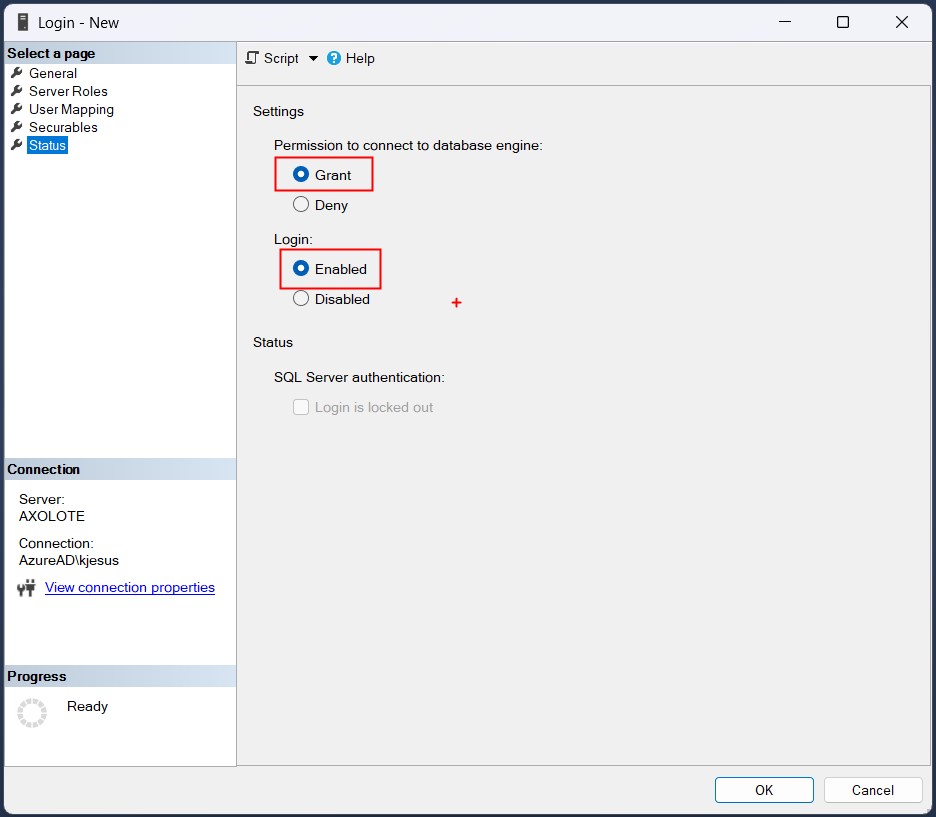
- If you choose to run SQL Server Jobs through T6 Enterprise Workflow tasks, you will need to define specific roles for the T6 Enterprise user in SQL Server, as described below.
- On the User Mapping page, under Users Mapped to This Login, check the Map checkbox for the msdb database.
- Under Database Role Membership, select Public and SQLAgentUserRole. In the msdb.dbo.sysjobs table, SELECT access must be granted using the command **USE msdb GRANT SELECT ON msdb.dbo.sys
jobs TO useName**.
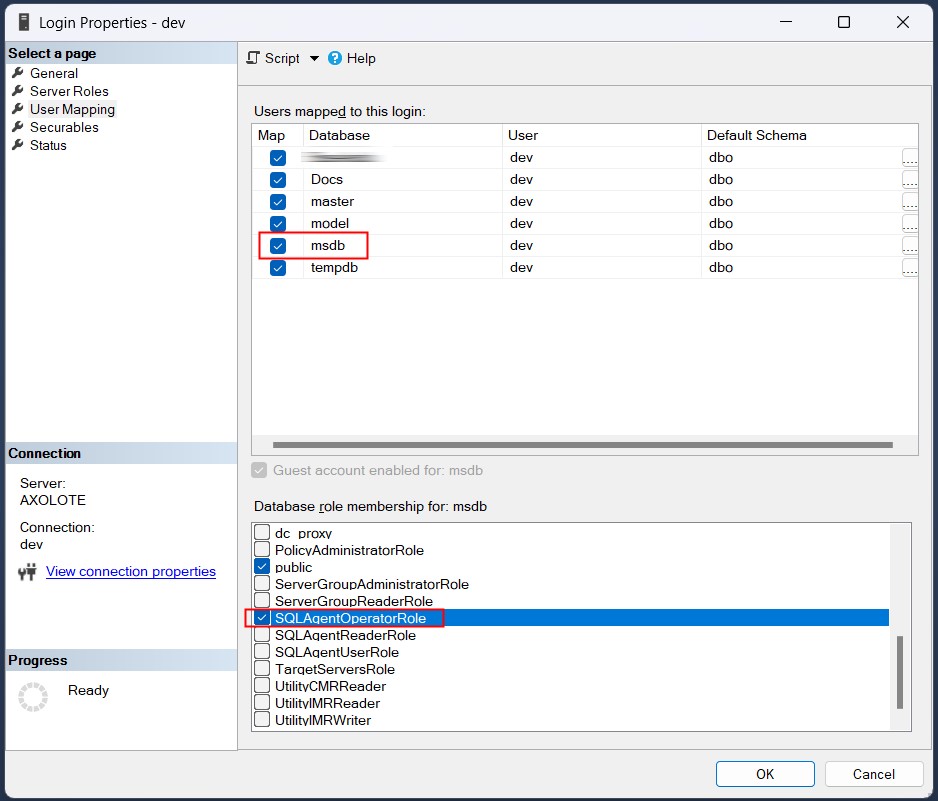
- If it is necessary to filter these Jobs, T6 Enterprise provides a parameter indicating a Database View responsible for filtering specific Jobs. To configure the View, follow the instructions below.
- Access the T6 Enterprise menu -> Modeling -> Other -> Parameters. Fill in the value of the databasejobsview parameter with the name of the View to be used. This View must necessarily contain the jobid, jobname, and jobdescription fields.
¶ 2.3.3 Web Server (IIS)
- Necessary Role Services: Some features are necessary for using T6 Enterprise on Internet Information Service (IIS), as shown in the list below.
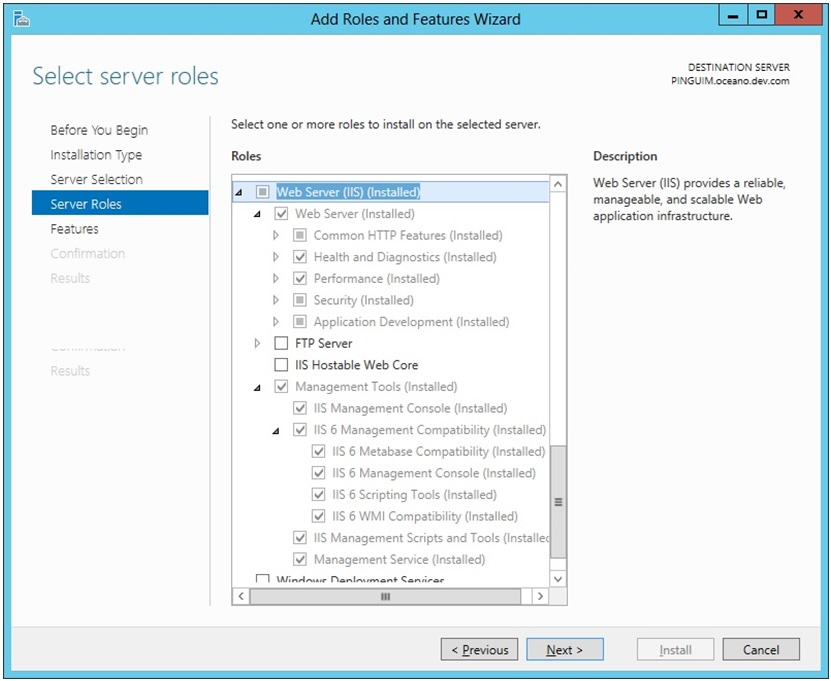
In the next step, verify that all options for .Net Frameworks v3.5 and v4.5 are selected.
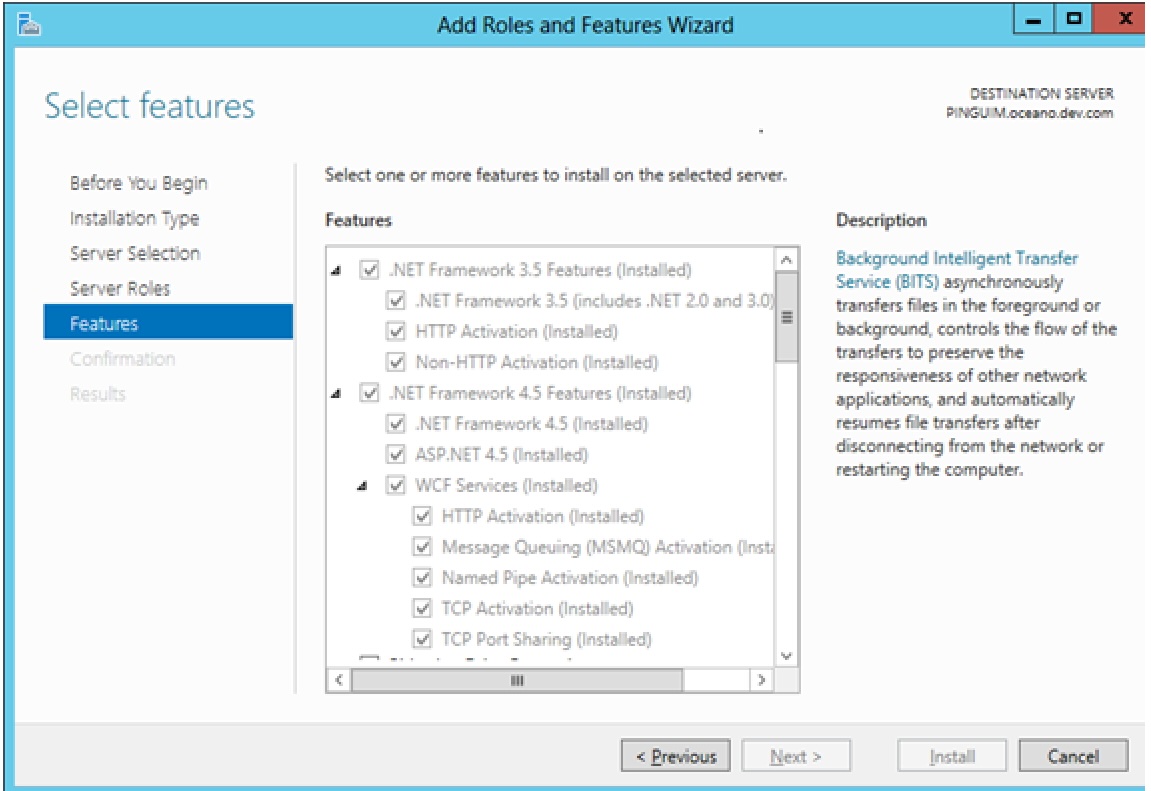
¶ 3. T6 Enterprise Installation Manual
¶ 3.1 Overview
This manual aims to provide a step-by-step guide on using the installer for the new T6 Enterprise product.
¶ 3.2 EXECUTABLE
To obtain an executable file for T6 Enterprise, simply open the following URL in your browser, and the executable will be downloaded: Installer.exe
¶ 4. T6 Enterprise Installation
- After downloading the installer, double-click the icon to run it:
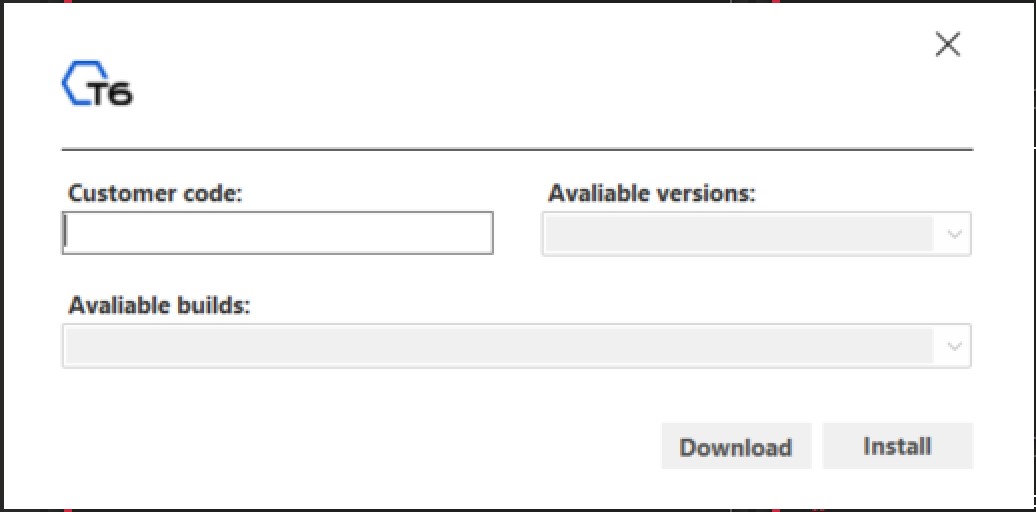
- Client Code: In this field, enter the valid client code provided by the sales representative.
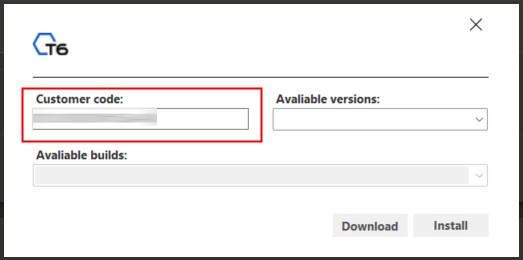
- Available Versions: This field will be activated after entering a valid client code and will allow you to choose between product versions. Note that only versions for which the client has permission will be displayed.
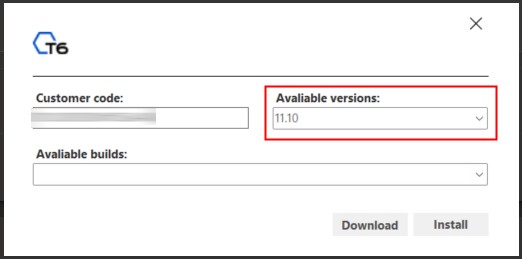
- Available Builds: In the available builds field, you can choose which version you want, keeping in mind that the versions displayed will depend on the product version defined in the available versions field.
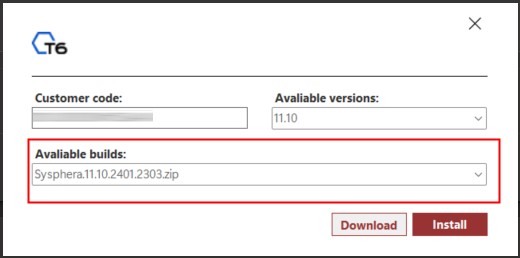
- Download Button: After setting the three previous fields, two buttons will be enabled, one of them being the Download button, which will download the T6 Planning installer file to your device for execution whenever you want.
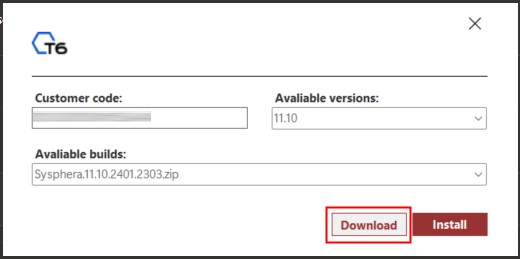
- Install Button: Unlike the Download button, the Install button will not download the file to your device but will proceed directly with the product installation.
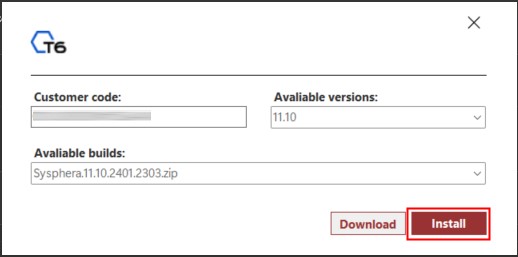
From the next topic, we will teach you how to install the product as well as prerequisites necessary and how to update the system.
¶ 5. T6 Enterprise System Installation Manual
¶ 5.1 Overview
This manual is intended to provide instructions on how to perform the T6 Enterprise installation, including configurations, requirements, and version updates, from the perspective of the new T6 Enterprise installer.
¶ 6. T6 Enterprise Installation
¶ 6.1 Overview
In this chapter, we will cover the installation of T6 Enterprise, from the moment of unpacking the installer and going through the actual installation, to the installation testing stage.
¶ 6.2 Unpacking the Installer
Unzip the contents of the T6 Enterprise 11.1_xxxxxxx.zip file into a folder of your choice, where a folder named T6 Enterprise will be created automatically. Open this folder and locate the Installer.exe file. Double-click on it to run the T6 Enterprise installer.
¶ 6.3 Running a T6 Enterprise Installation
Before starting the T6 Enterprise installation, it's important to note that it can only be performed by a user with Administrator access to the operating system. The T6 Enterprise installer has three installation languages, namely Portuguese, English, and Spanish. The language used in the installation will be automatically determined by the installer, based on the user's operating system language.
Upon running the installer, you will see a brief description of T6 Enterprise on the initial screen. To proceed with the installation, click the Next button.
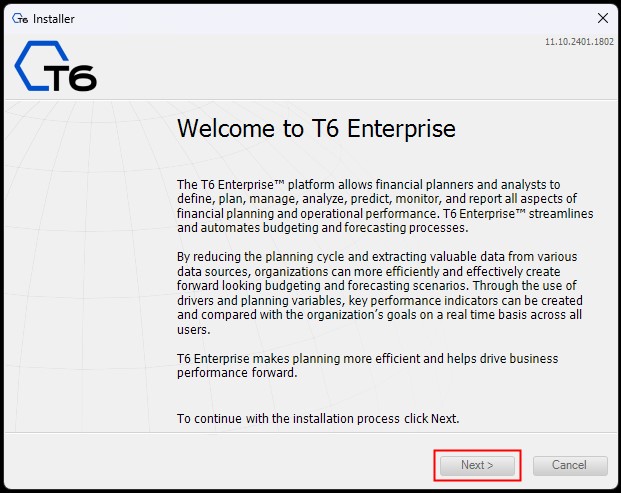
This screen will display the available Installation Types, which are: New Installation, Upgrade Previous Installation, and Remove Previous Installation. Select the desired installation type and proceed to the next screen.
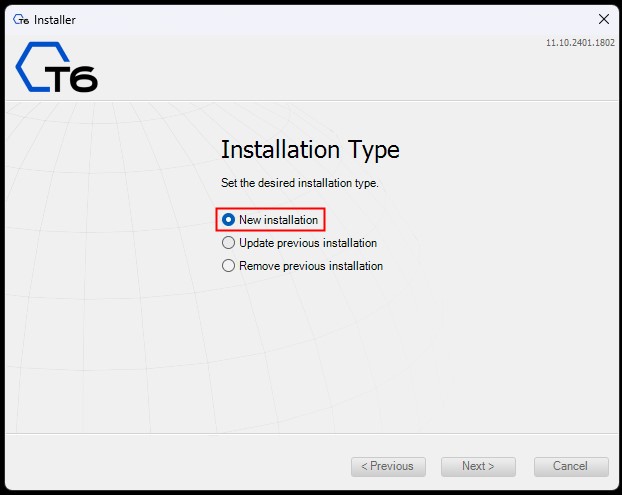
The next screen will display the License Agreement. Carefully read the license terms, and if you disagree, click Cancel to exit the installer. If you agree to the terms, proceed to the next screen.
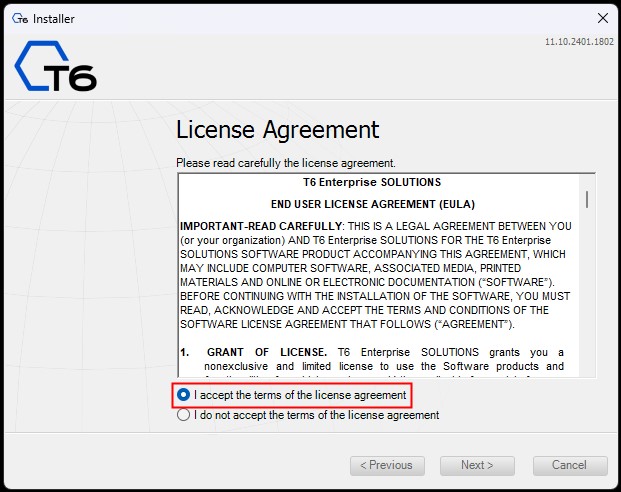
On the Customer Information screen, you will need to enter a valid License File or the Customer Code to proceed with the installation.
To obtain the license, access the T6 Enterprise Support Site and download the license file for the respective version to be installed, saving it in the T6 Enterprise installation folder.
To obtain the Customer Code, contact the sales department and request the code. This code will automatically bring in your licenses without the need to search or download them from the support site.
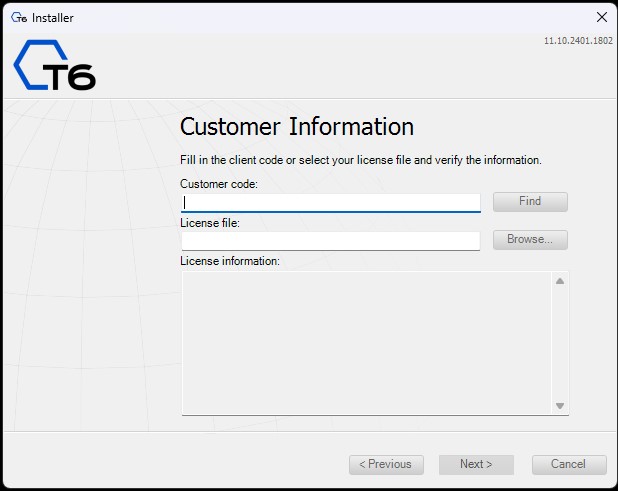
Click the Browse button, locate the license.xml file, or enter the Customer Code. Then proceed to the next screen. If the entered file or code is invalid, the installer will prevent the continuation of the process. In case of doubts, contact the responsible sales representative.
Important
If there is already a previous T6 Enterprise installation, the License File field will automatically display the license.
On the Installation Modules screen, you will determine whether the module to be installed will be exclusively for the T6 Enterprise Portal (standalone), with a Data Provider, or integrated with Microstrategy. It is important to note that the T6 Enterprise installer allows the selection and installation of multiple modules simultaneously.
For more details, refer to the manual regarding the integration of T6 Enterprise with Microstrategy.
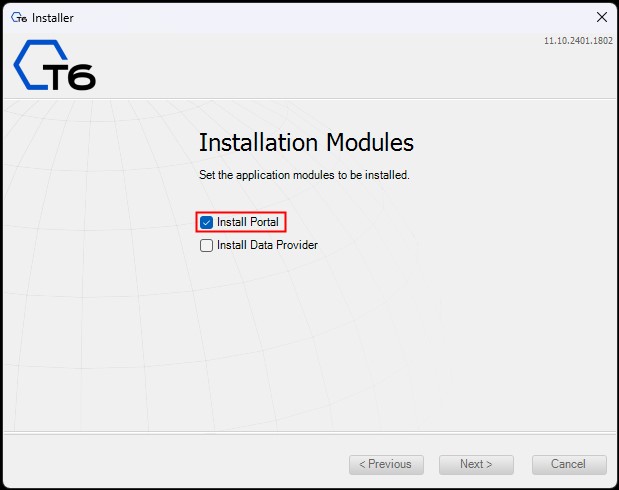
The next screen will display the prerequisites for installation based on the modules selected on the previous screen. The installer will indicate if there are any optional requirements to be installed. If any mandatory prerequisites are not installed, the installer will notify and prevent the installation of T6 Enterprise until all prerequisites are properly installed.
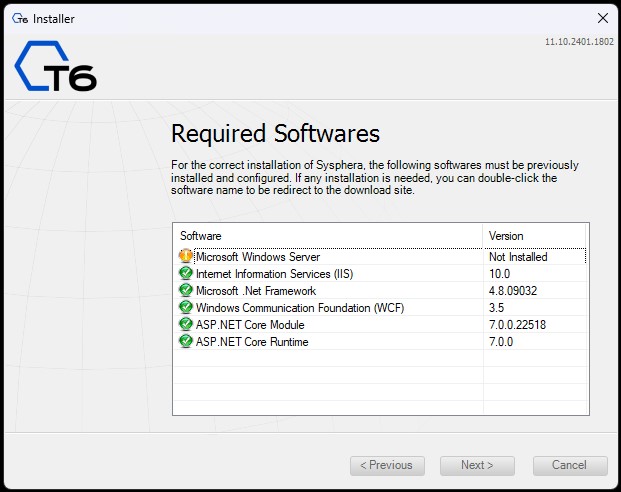
On the next screen, select the directory where the Portal will be installed and proceed to the next screen.
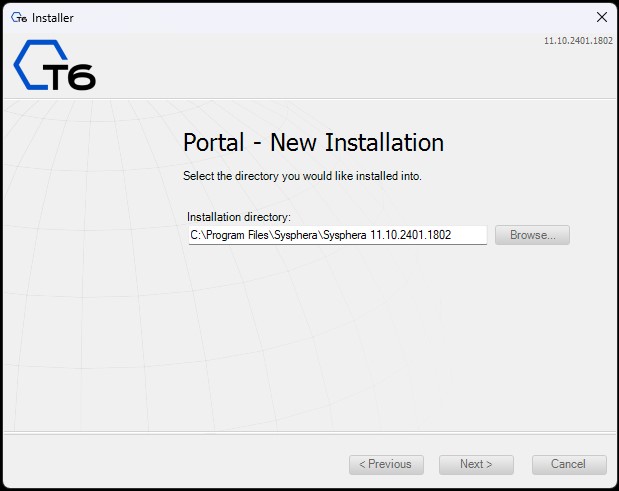
On the following screen, you should provide the database settings:
- In the Server field, enter the SQL server name (do not use localhost).
- In the Port field, the default port to be entered should be 1433. If the port has been configured to a different value on your SQL Server, fill in the Port field with this value. If you are unaware of the port, you can use the Dynamic Port option, provided that the SQL Server Browser is running on the SQL Server.
- In the Username field, enter the new T6 Enterprise user, which is the SQL login created for this purpose.
- In the Password field, enter the password you defined for the new T6 Enterprise user, which is the SQL Server login created for this purpose.
- If you opted for SQL authentication, the Windows Authentication checkbox should be unchecked. If you choose to check it, the Username and Password fields will be disabled, and you will provide them later on the Services Settings screen.
- In the Database field, choose the T6 Enterprise database created for this installation.
- The "Do Not Create Tables" checkbox should not be checked when performing a new installation. This option can only be used when updating an installation, where an existing and correctly configured T6 Enterprise database with all the necessary tables can be used.
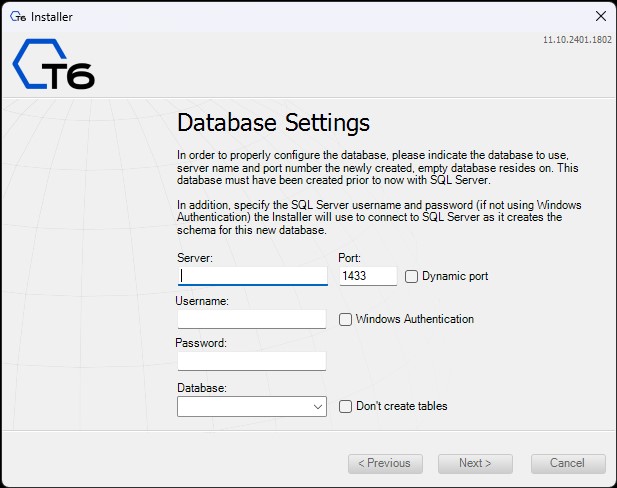
The next screen is for T6 Enterprise Analytics settings, and its completion is optional:
- In the Server field, enter the SQL server name (do not use localhost).
- In the Port field, the default port to be entered should be 1433. If the port has been configured to a different value on your SQL Server, fill in the Port field with this value. If you are unaware of the port, you can use the Dynamic Port option, provided that the SQL Server Browser is running on the SQL Server.
- In the Username field, enter the new T6 Enterprise user, which is the SQL login created for this purpose.
- In the Password field, enter the password you defined for the new T6 Enterprise user, which is the SQL Server login created for this purpose.
- If you opted for SQL authentication, the Windows Authentication checkbox should be unchecked. If you choose to check it, the Username and Password fields will be disabled, and you will provide them later on the Services Settings screen.
- In the Database field, choose the T6 Enterprise database created for this installation.
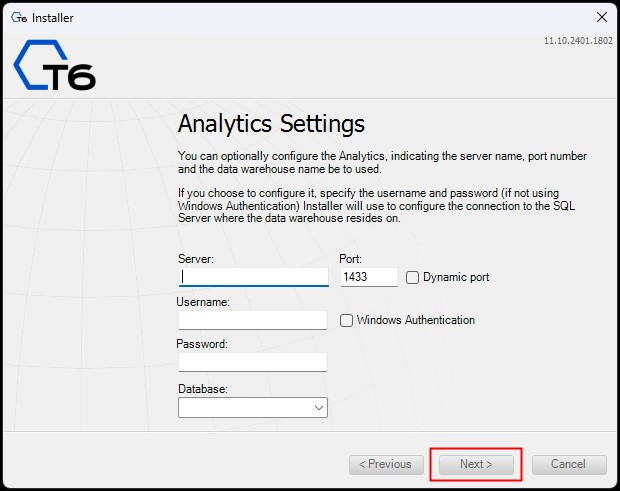
On the next screen, enter the data for the Services Settings:
- In the Reporting Services URL field, enter the Report Server URL.
- In the Username field, enter the SQL or Windows user login, depending on the authentication method selected in the previous screens. This user will be responsible for running the T6 Enterprise Application Pool.
- In the Password field, enter the password for the specified user.
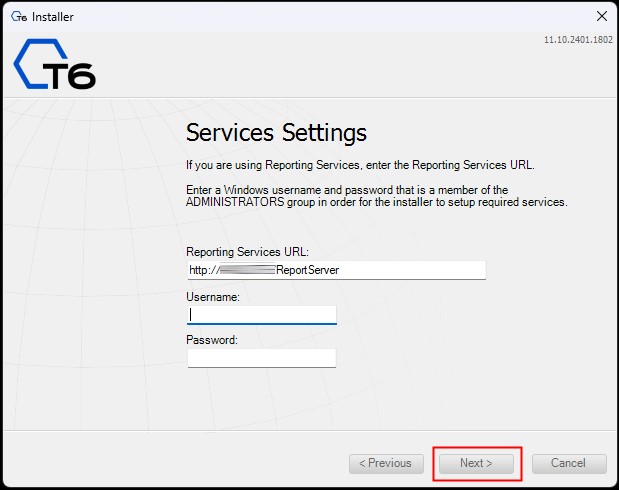
On the Application Portal screen, enter the name of the UX portal and the name of the Portal to be created in IIS, which will be used in the URL to run the T6 Enterprise application. If the Internet Information Services (IIS) has more than one configured site, the T6 Enterprise installer will show the option to Select the IIS Site, allowing you to choose which site the portal will be installed on.
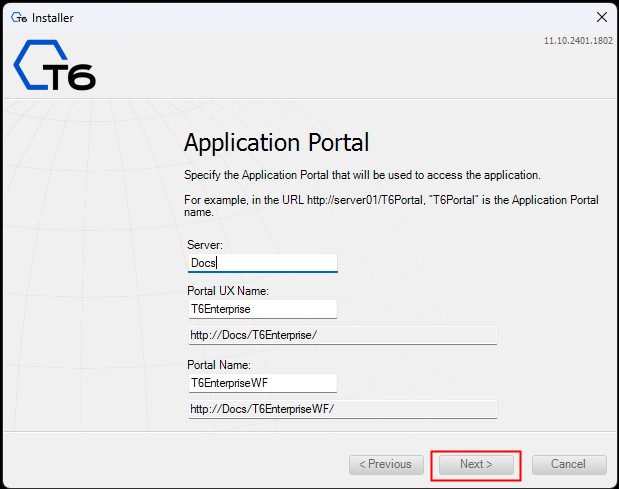
Important
If there is already a portal installed with the same name as the one now provided, it will not be possible to proceed with the installation. In this case, use a different name for the UX Portal creation.
The next screen deals with MicroStrategy parameters.
If the installation is integrated with Microstrategy, check the Integrate T6 Enterprise Portal with Microstrategy checkbox and enter the Microstrategy parameters in the respective fields. For more details, refer to the manual regarding the integration of T6 Enterprise with Microstrategy.
If the installation is not integrated with Microstrategy, simply leave the checkbox unchecked and proceed to the next screen.
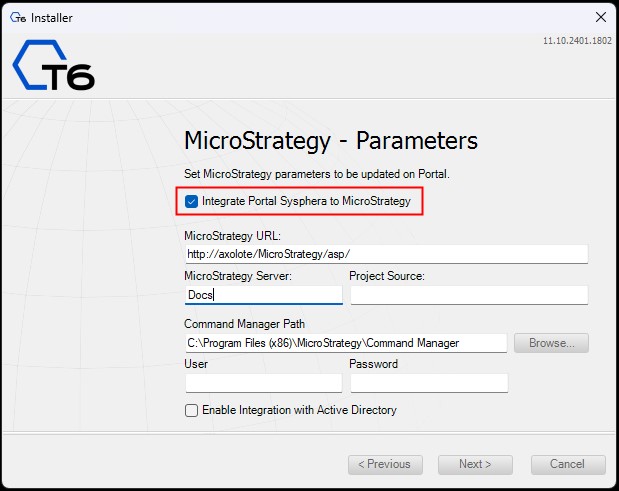
On the Confirm Installation screen, review the installation summary. If everything is correct, click Install. If you want to modify any parameter, click Previous.
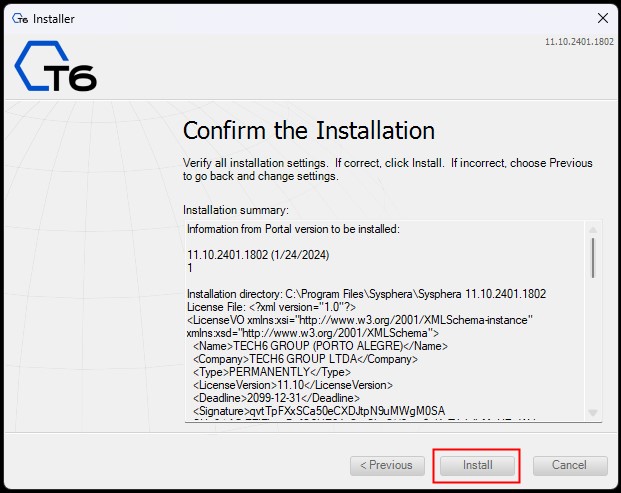
On the Installation Progress screen, you will monitor the entire installation process.
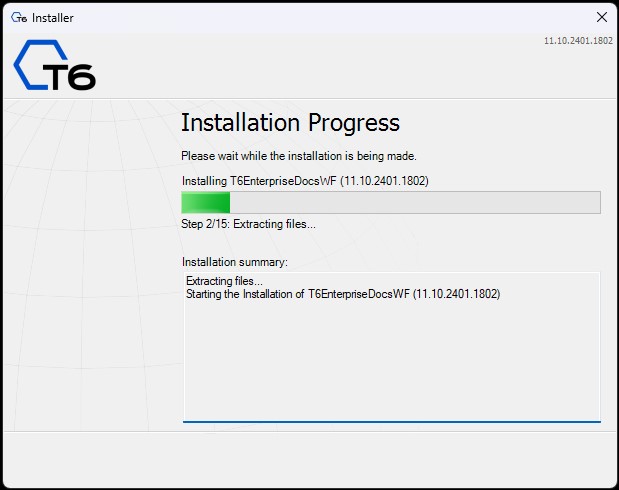
On the final screen, the summary will display information regarding the installation. Click Finish to close the installer.
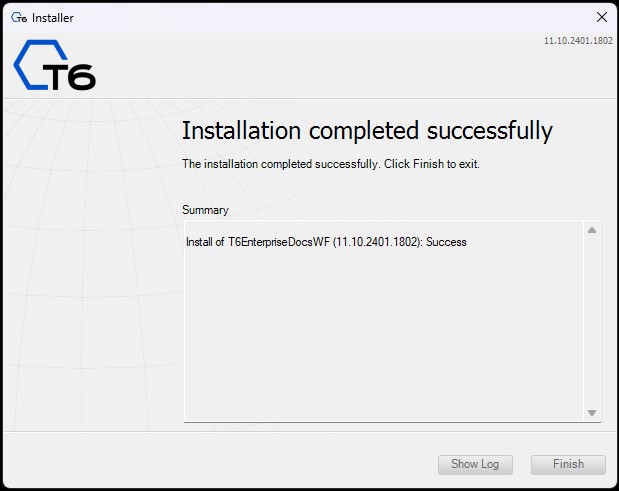
Note
If you encounter any errors, refer to the Troubleshooting chapter in this manual.
¶ 6.4 Testing the Installation.
When accessing the Windows Start Menu, you will find the shortcut to the newly installed T6 Enterprise application. Clicking on the shortcut will display the T6 Enterprise access portal. If the access portal is not displayed, refer to the Troubleshooting chapter in this manual.
Note
The browser used must support JavaScript.
¶ 6.4.1 Performing the First Access
For your first access, open the T6 Enterprise access portal, enter the user (admin) and password (password), and click Login.
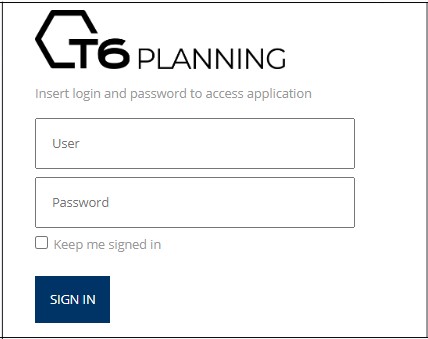
¶ 6.4.2 Creating the First Application
When accessing T6 Enterprise for the first time, you should click on the side menu and go to Explorer > Browser. After that, in the top menu of the screen, there will be an option called "New Item." Clicking on it will display a dropdown of options; you should select the Modeling option and then Application.
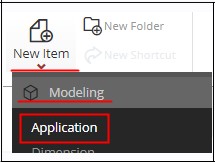
Finally, create your application by entering the desired name and clicking Save.
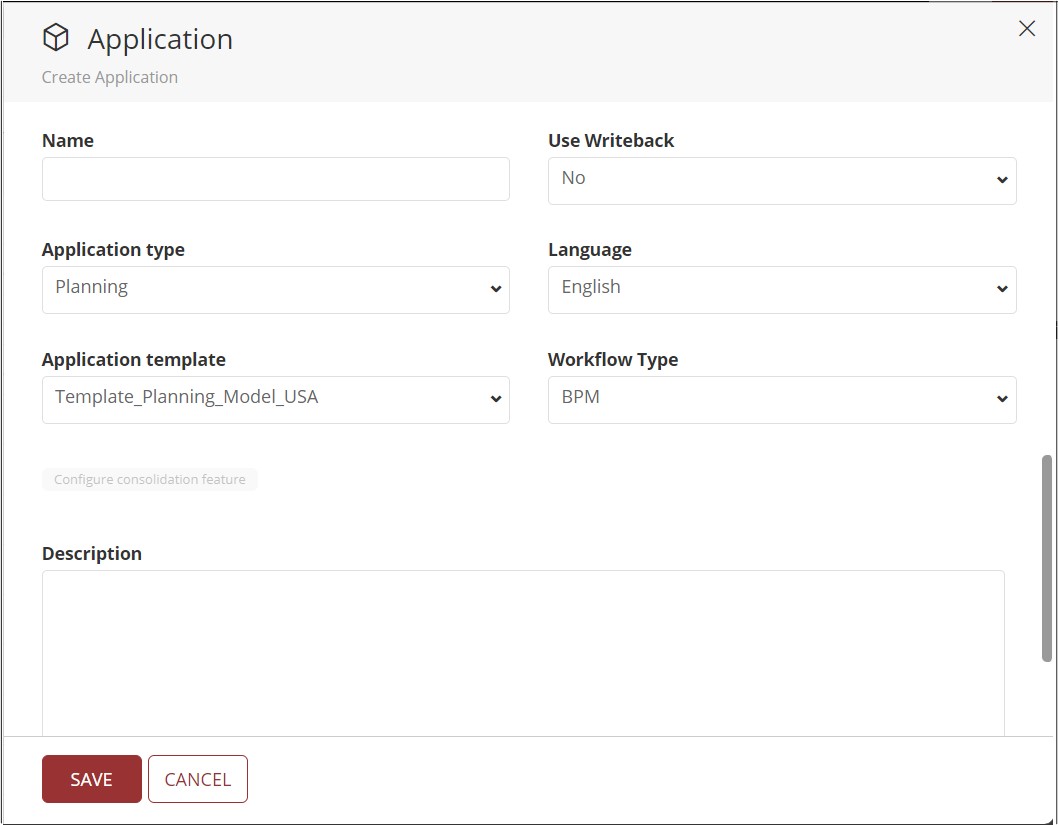
¶ 7. T6 Enterprise Update
¶ 7.1 Overview
In this chapter, we will cover the update of an already installed version of T6 Enterprise.
¶ 7.2 Portal Backup
Whenever an update is performed, the T6 Enterprise installer automatically backs up the portal for security reasons. A folder is created by the installer in the same directory where T6 Enterprise was initially installed.
The following example shows the nomenclature used to uniquely identify a backup directory created during the update process of a T6 Enterprise installation:

The red part identifies the name of the original Portal that was updated.
The blue part shows the version number of the original T6 Enterprise Portal installed.
The orange part is the unique identifier number for the original installation, for this version.
If there is a need to revert the T6 Enterprise Portal to the previous state before the update process, simply rename the backup directory with the name used before the update and then restart the Application Pool in IIS.
Note: Before starting to update the portal, it is best to always perform a database backup first, if the update presents problems you will not lose your data.
¶ 7.3 Extracting the Installer
Unzip the contents of the file T6 Enterprise 11.1_xxxxxxx.zip into a folder of your choice, where a folder named T6 Enterprise will be automatically created. Open this folder and locate the file Installer.exe. Double-click on it to start the update process for T6 Enterprise.
¶ 7.4 Running the T6 Enterprise Update
Before initiating the T6 Enterprise update, it's important to note that it can only be performed by a user with Administrator access to the operating system.
The T6 Enterprise installer supports three installation languages: Portuguese, English, and Spanish. The installer will automatically determine the language based on the user's operating system.
Upon running the installer, you will see a brief description of T6 Enterprise on the initial screen. To proceed with the update, click the Next button.
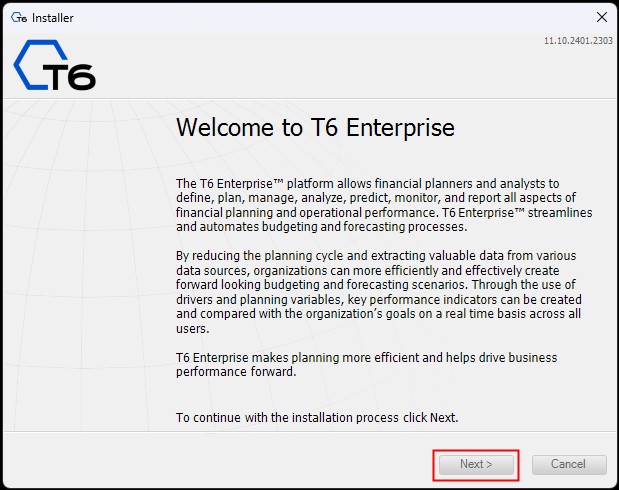
The next screen will display available Installation Types. Select the option Update Previous Installation and proceed to the next screen.
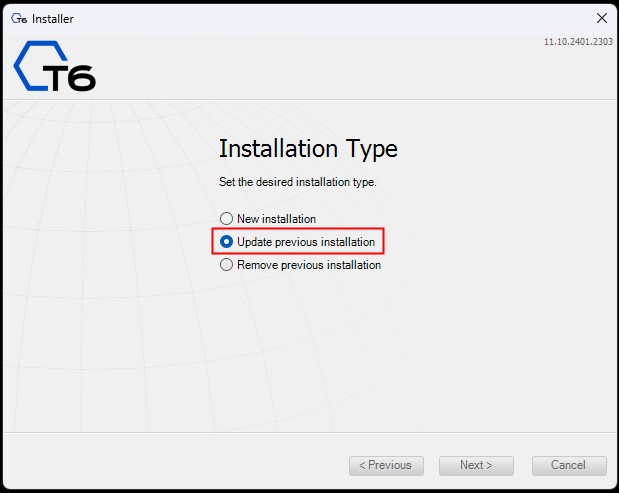
The following screen will show the License Agreement. Carefully read the license terms and proceed to the next screen.
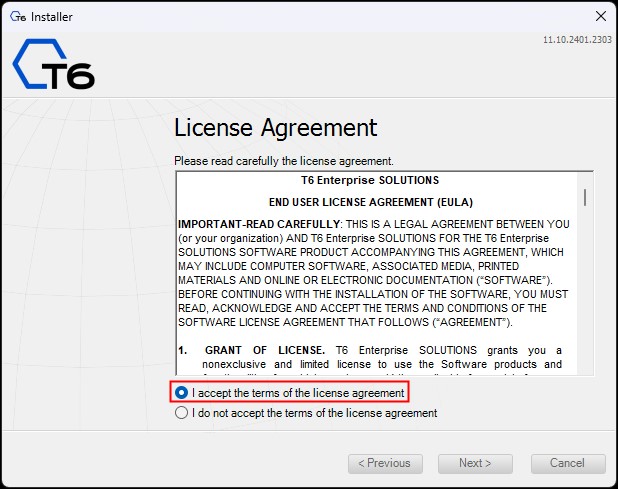
The Installation to be Updated screen presents a list of T6 Enterprise products installed on the computer, along with a summary of each installation. Select one or more installations to be updated.
If you only want to change the database connection settings of an existing installation, check the Change Database Connection Settings checkbox.
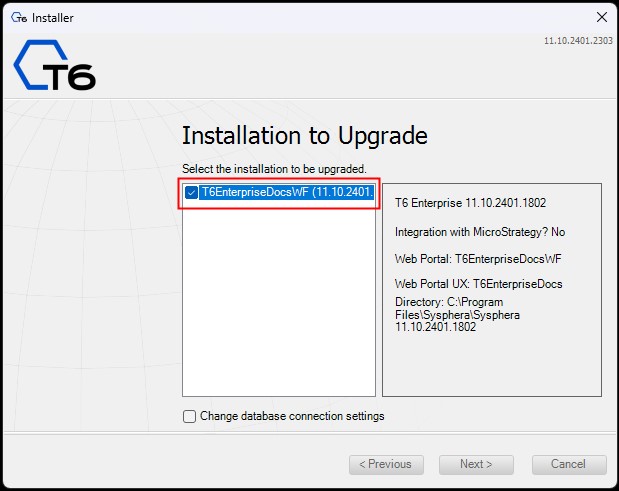
Note: If you want to change the database connection settings and update the T6 Enterprise portal, you need to run the installer twice. Once to change the database settings as described above, and the second time to effectively update the portal.
On the Confirm Update screen, review the update summary and click Update.
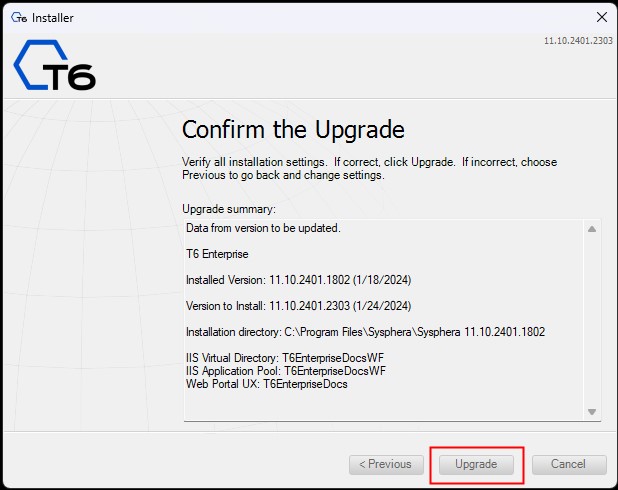
On the next screen, the installer will issue a warning, asking for permission to restart IIS. Click Yes to proceed with the update.
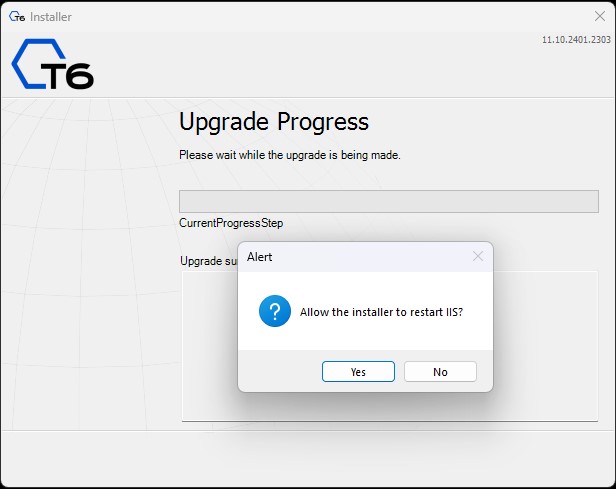
On the Update Progress screen, you will track the entire update process.
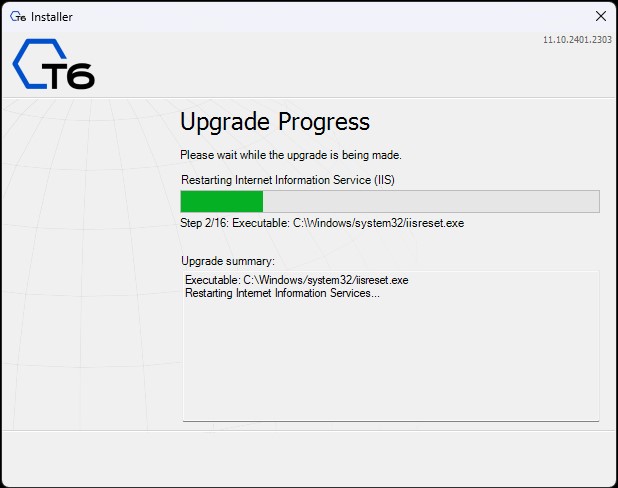
On the final screen, the summary will display information about the update. Click Finish to close the installer.
If you encounter any errors, refer to the Troubleshooting chapter in this manual.
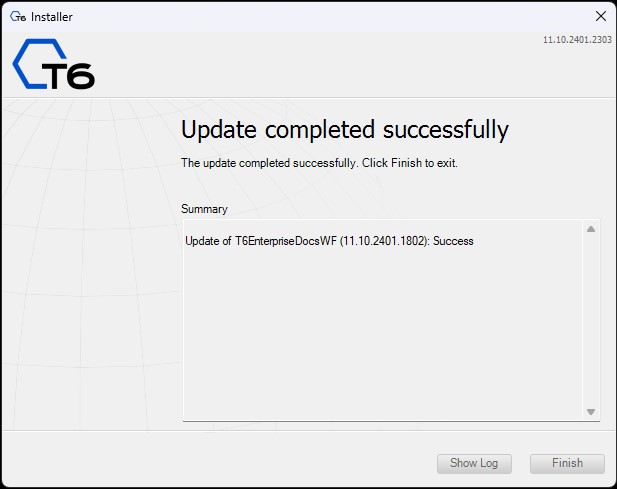
¶ 7.5 Performing a Manual Update
Manual update is recommended if you need to restore a database from a build lower than the one installed on the portal.
This often happens in environments with Production and Staging servers. In these environments, T6 Enterprise tests are conducted on the Staging server's database before updating the Production server.
In this scenario, it's common to back up the Production server's database and restore it on the Staging server. This results in the Staging portal having a build higher than the database.
After this restoration process, the portal may stop functioning since there are structural changes in the database between builds. These changes need to be applied to the restored database for the T6 Enterprise solution to work correctly.
To restore a lower build database and then manually update the portal, follow these steps:
- Restore the desired database.
- Access the Url: http://T6Enterpise_server/WebForm/Update.aspx to perform the update automatically. Please note that this update can only be done when both databases are on the same T6 Enterprise version.
¶ 8. Updating T6 Enterprise License
¶ 8.1 Overview
This chapter explains how to update the T6 Enterprise license through the system interface using the Customer Code.
¶ 8.2 Updating the Customer Code Within the System
To obtain the Customer Code, simply request it from our sales department, and they will provide you with the specific Customer Code for each client. Once you have the code, access your environment and go to Sidebar Menu > Settings > Parameters.
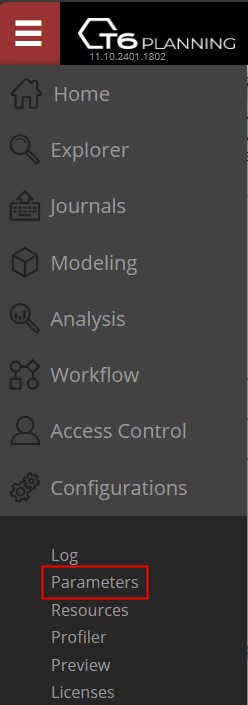
Next, access the integration option and look for the parameter called Customer Code, and then fill in the field with your code.
If you installed the product with the Customer Code, this configuration won't be necessary as the system will automatically fill in this parameter when using the code during installation.
¶ 8.3 License Synchronization
After filling in the parameter with the Customer Code, access again Sidebar Menu > Settings > Licenses and click on the option in the top right corner "Sync." After this, the system will bring the available license for that version you are accessing, in case yours is close to expiration and the renewal has been done.
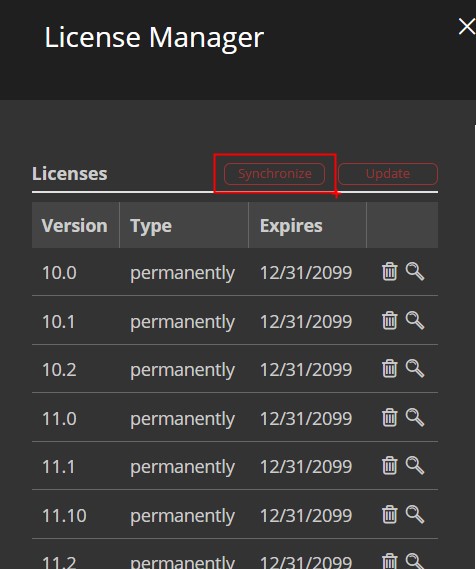
¶ 9. Uninstalling T6 Enterprise
¶ 9.1 Overview
This chapter explains how to uninstall T6 Enterprise, which is done through the installer itself.
¶ 9.2 Extracting the Installer
Unzip the contents of the file T6 Enterprise 11.1_xxxxxxx.zip into a folder of your choice, where a folder named T6 Enterprise will be automatically created. Open this folder and locate the file Installer.exe. Double-click on it to run the installer.
¶ 9.3 Uninstalling T6 Enterprise
Before running the T6 Enterprise installer, it's important to note that uninstallation can only be performed by a user with Administrator access to the operating system. The T6 Enterprise installer supports three display languages: Portuguese, English, and Spanish. The installer language will be automatically set based on the user's operating system.
Upon running the installer, you will see a brief description of T6 Enterprise on the initial screen. To proceed with uninstallation, click the Next button.
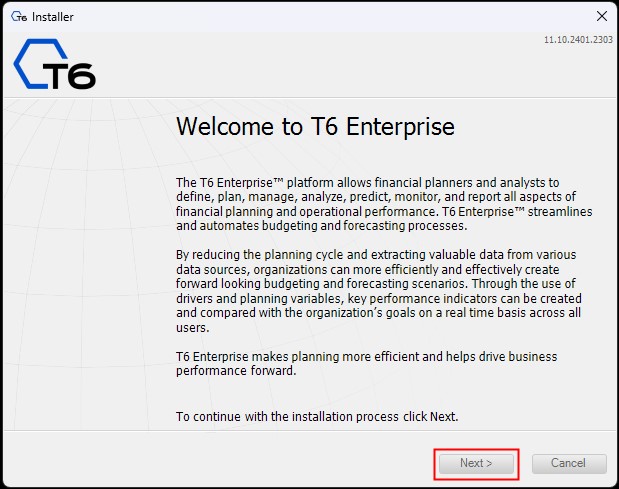
The next screen will display available Installation Types. Select the option Remove Previous Installation and proceed to the next screen.
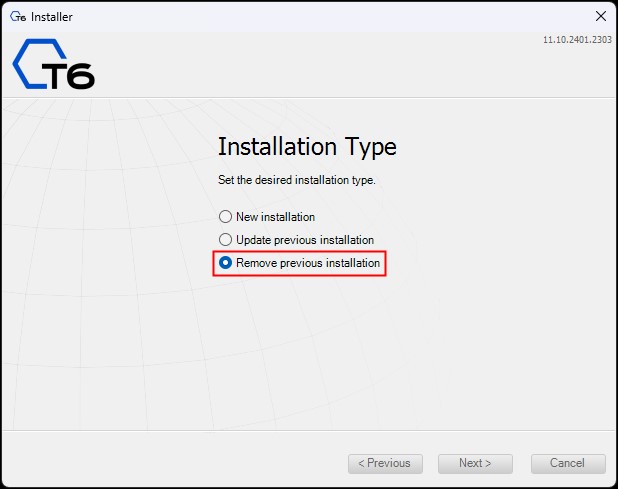
On the Confirm Uninstallation screen, review the items to be uninstalled and click Remove.
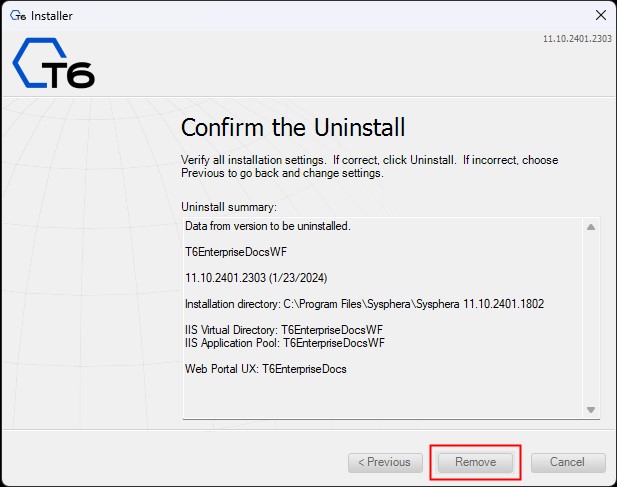
On the Uninstallation Progress screen, you will track the entire uninstallation process.
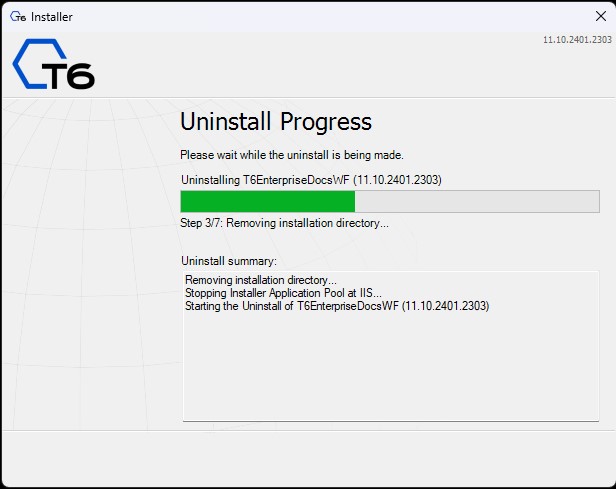
On the final screen, the summary will inform you that the uninstallation was successful. Click Finish to close the installer.
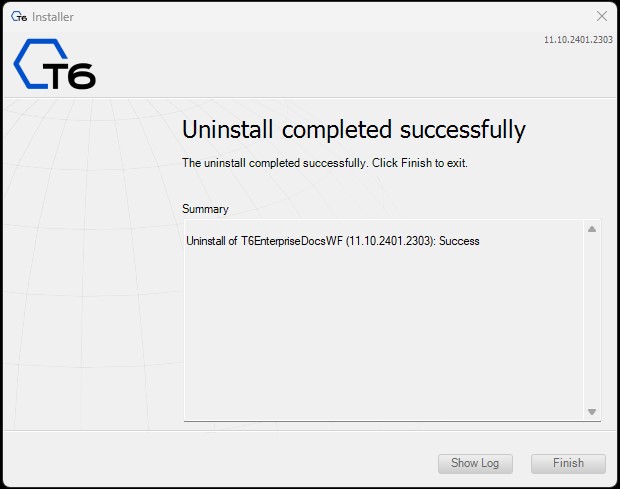
¶ 10 Troubleshooting
¶ 10.1 Overview
This chapter focuses on resolving any potential issues during the installation or update of T6 Enterprise.
¶ 10.2 Installation
In this section, we will describe some errors that may occasionally occur during a T6 Enterprise installation, along with their respective solutions.
¶ 10.2.1 Error Running the T6 Enterprise Installer
When attempting to run the T6 installer, Windows Defender may not allow the execution of the .exe file.
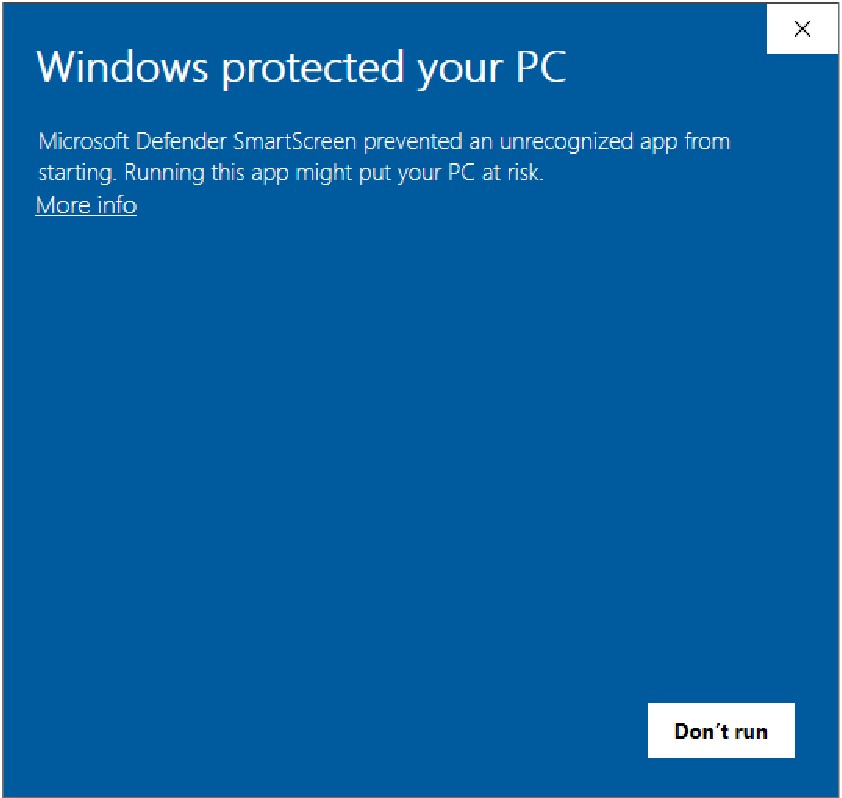
To work around the issue, simply access the file location, right-click, and go to the file properties.
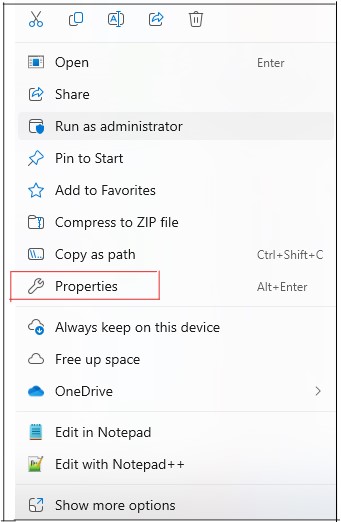
In the properties window, go to the end of the screen and select the 'Unblock' option, apply the change, and run the installer again.
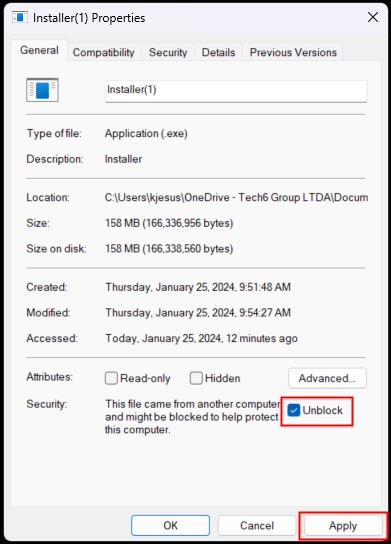
¶ 10.2.2 Create default permission denied in database 'databasename'
This error occurs when the user created within the SQL Server for T6 Enterprise installation does not have permission to create the application's T6 Enterprise tables. To solve the problem, follow the steps below:
- Open Microsoft SQL Server Management Studio and locate, in the Object Explorer, the level Security -> Logins -> T6 Enterprise_user_name.
- Right-click on the user name and then click Properties.
- In the Login Properties window, select the User Mapping page, and in the information for the database created for T6 Enterprise installation, make sure the user in question is marked as db_owner in the Database Role Memberships list.
¶ 10.2.3 Portal Doesn't Load or Doesn't Appear
When trying to open the portal, a message is displayed as shown in the images below:
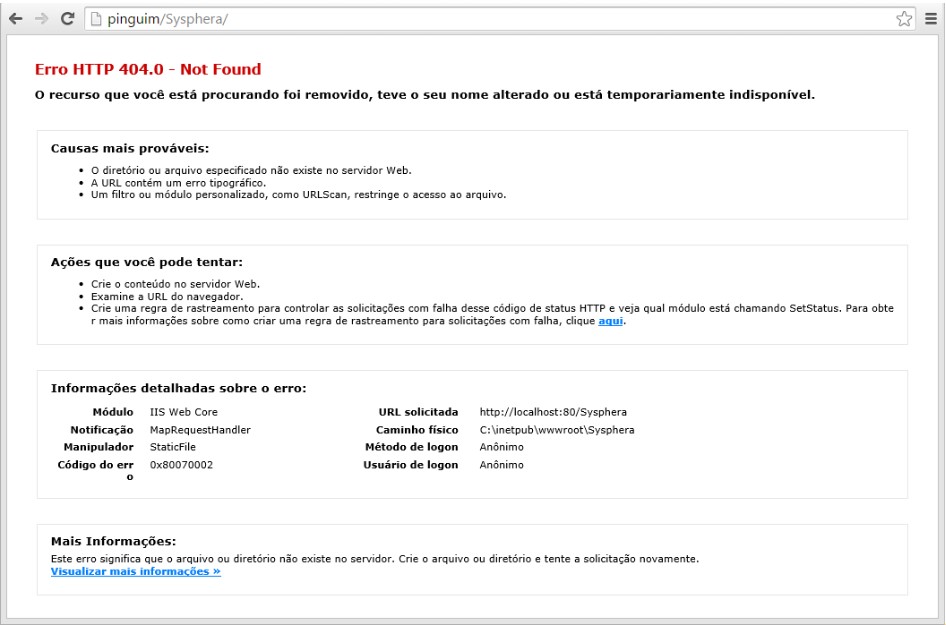
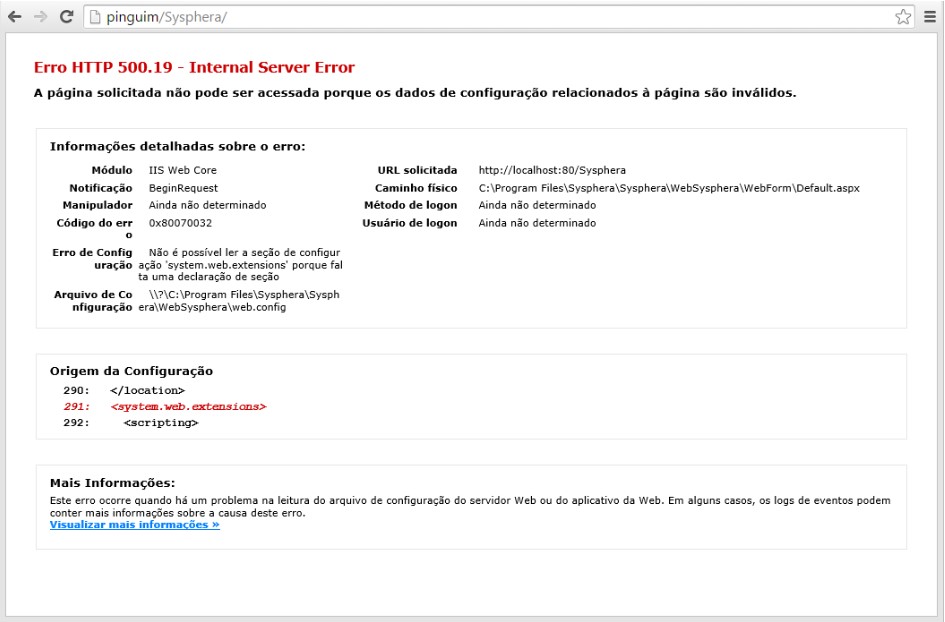
This error occurs when ASP.NET access is not configured in IIS. To resolve the issue, follow the steps below:
- Access the IIS Manager.
- Click on ISAPI and CGI Restrictions.
- Select the ASP.NET v4 options and set them to Allowed in the Restriction column.
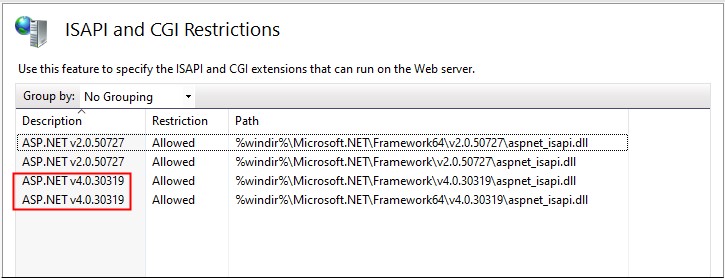
¶ 10.2.4 Report Viewer Configuration Error
The HTTP handler for the Report Viewer Web Control was not registered in the application's web.config file.
- Message: The HTTP handler for the Report Viewer Web Control was not registered in the application's web.config file. Add to the system.web/httpHandlers section of the web.config file, or add <add
name="ReportViewerWebControlHandler" preCondition="integratedMode" verb="*"
path="Reserved.ReportViewerWebControl.axd"type="Microsoft.Reporting.WebForms.HttpHandler,
Microsoft.ReportViewer.WebForms, Version=11.1.0.0, Culture=neutral, PublicKeyToken=89845dcd8080cc91" /> to the
system.webServer/handlers section for Internet Information Services 7 or later.
To resolve this issue, switch the T6 Enterprise pool to classic mode.
¶ 10.3 Update
During the update process, the installer may display error messages related to ongoing updates or adjustments that need to be made to the portal but do not interfere with the update.
Below are some examples of error messages along with the recommended actions to correct the issue.
- Installer version is lower than the version to be updated.
- In this case, check if the downloaded installer version is correct and make the necessary adjustments.
- The version to be installed must always be higher than the current version.
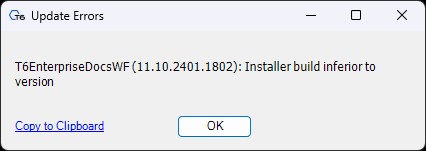
- Installer version is equal to the version to be updated.
- In this case, check if the downloaded installer version is correct and make the necessary adjustments.
- The version to be installed must always be higher than the current version.

- Application Unlock:
- The message indicates the blocked application and the user responsible for the lock.
- In this case, access T6 Enterprise and unlock the specified application.
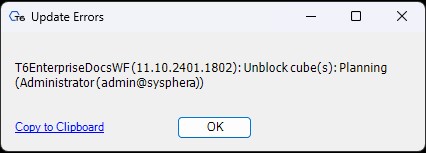
-
Application Publishing.
- The message provides the name and code of the application that needs to be published.
- In this case, any user with publishing permission can access T6 Enterprise and perform the required publication.
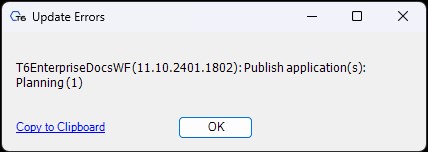
-
Update Failed
- In this situation, analyze the summary and identify the issue to apply the appropriate solution.
- After fixing the error, run the installation update again.
- The installer will always detect when the update was not successful and give the option to retry.
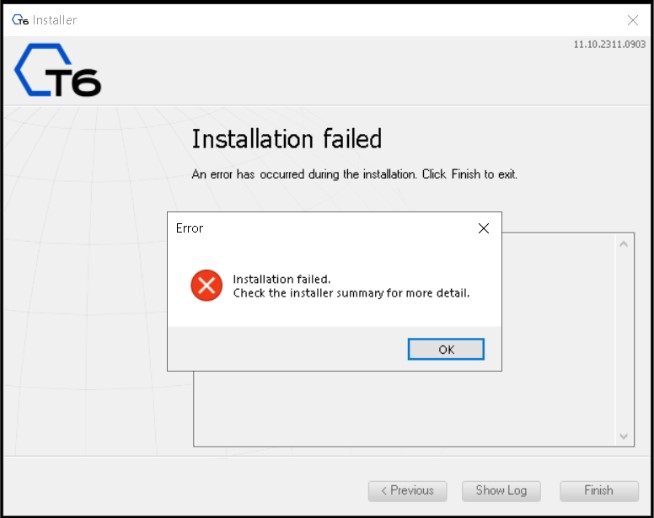
Other critical errors may occur during the Update Progress. In these situations, it is recommended to consult the detailed log stored in the C:\Program Files\T6 Enterprise\T6 Enterprise Installer\Logs folder. This log provides a comprehensive view of the update process, allowing you to locate and address the problem, ensuring a successful update.